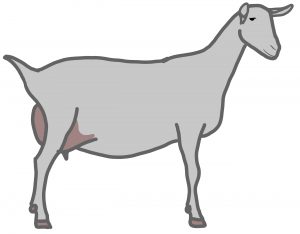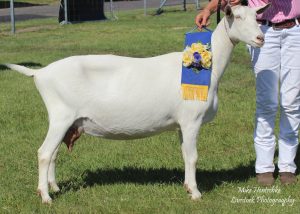Saanen
History
Saanens in Australia began as improvements on settler goats were made by the Department of Agriculture in New South Wales (NSW) importing two bucks and several does of the breed. The imports came from France and Switzerland and were located on the Experimental Farm at Nyngan, NSW. The imports were good quality animals and produced excellent milking stock. A further two bucks were added to the Nyngan herd in 1929. At around the same time Saanens from England were imported into Queensland. All the imported goats had a long term influence on the breed, building up a large breeding pool of high quality animals. The Nyngan farm closed in 1933, but in 1944 the NSW State Government established a similar farm at Condobolin. Female descendents of Nyngan bloodlines were bred to two foundation bucks, forming the ‘State’ stud. Over time the State stud imported a number of other bucks and does, strengthening the Saanen bloodlines. Combined with Saanen stock imported by many non-government studs, the breeding program allowed the Saanen to be developed into a high-class milking goat. Good breeding and management has brought the Australian Saanen a number of world records for production, establishing a strong reputation as a dairy breed. Its placid nature and strong milk production along with the numbers available had made the Saanen a popular choice among goatkeepers.
Breed Standard
GENERAL APPEARANCE (style & quality): Attractive dairy type, revealing vigour, femininity in does or masculinity in bucks, with harmonious blending and correlation of parts, showing no tendency to coarseness.
HEAD (skull eyes, ears, mouth, nostrils):Head slender, medium length, well balanced on neck, facial line dished or straight, skull broad between eyes, polled or neatly disbudded. Eyes large and bright amber colour. Pricked ears, medium size carried well above horizontal. Mouth, well developed muzzle, broad lips, open nostrils. Side profile should show no tendency to undershot or overshot jaw.
NECK:Blending smoothly into shoulders, with or without tassels. Does long and slender. Bucks fine and strong, not coarse.
BACKLINE:Strong, straight and horizontal from withers to hips.
FOREQUARTERS:Lean, high withers, set well into shoulders, which should blend firmly into body. Chest wide and deep in bucks, showing medium width and depth in does.
BODY (barrel): Wedge-shaped, long barrel havingwell sprung ribs and deep frame extending directly to udder.
HINDQUARTERS:Gradual fall from hips to tail, good width between hips and between thurls. Rump broad and strong, pin bones wide and prominent.
LEGS (hooves):Straight and strong. Forelegs showing proportionate width to chest, hindlegs and hocks well apart. Hocks slightly bent when seen from side. Pasterns short and strong, hooves sound and well-shaped.
UDDER:Broad attachment high at rear and well forward in front and no pocket, not penduIous or unduly divided. Level sole, soft textured and showing good capacity. Skin tan.
TEATS:Of adequate size for ease of milking, well attached and distinct from udder. Set well apart, pointing slightly forward and down, not outward.
TESTICLES:Scrotum well attached, relatively even and not divided or unduly pendulous, carrying two testes.
RUDIMENTARY TEATS:Two, set wide apart slightly to the fore and side of the scrotum, of good size but not overdeveloped, unless the buck is milking.
SIZE:Does 81 cm (32 inches). Bucks 94 cm (37 inches).
COAT:Short and smooth. Bucks may have a longer coat.
COLOUR:Even white or cream, tan skin. Black spots may appear on ears, nose, eyelids and udder.
DIFFERING FROM IDEAL (found and recognised):Horned. Raised bridge to nose. Longer hair along back and down the quarters. Uneven tassels.
FAULTS:Cow hocks. Dropped pasterns. Roach back or sway back. Size differing substantially from ideal. Lack of dairy quality. Uneven gait. Lack of masculinity in bucks. Pink skin. Poor feet. Splayed feet. Low set ears. Weak or narrow chest. Shallow body. Steeply sloping rump. Even biscuit tinge as distinct from cream. Fleshly, pendulous or unduly divided udder. Pocket in udder. Teats: small; thin; large; bulbous; ill-defined; unbalanced. Lack of milking capacity. Divided, uneven or unduly pendulous scrotum. Spots on barrel smaller than a 10cent coin.
DISQUALIFICATIONS:Wry face. Double or supernumerary teats. Double orifices. Obviously undershot or overshot jaw (side profile). Undescended testicles in bucks or one testicle only. Pendulous ears. Off colour. Broken colour. Dark biscuit colour. Intersex. Patches on barrel larger than a 10cent coin.

